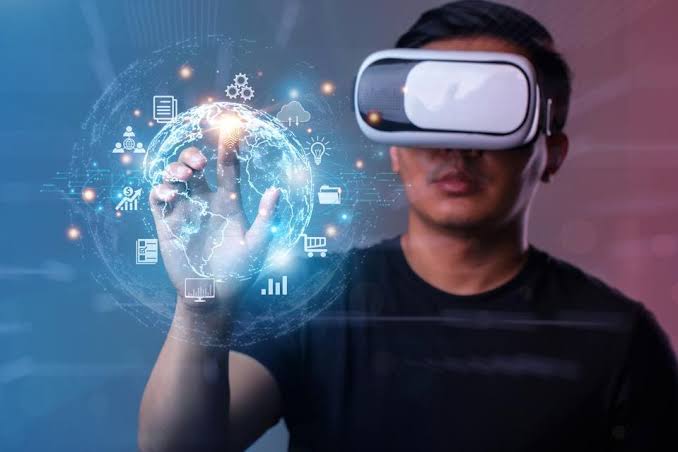Virtual reality (VR) technology has improved remarkably in recent years, changing the redefinition of how digital content is perceived. By creating VR headsets, this applies to an array of various industries, starting from gaming and entertainment to even education, healthcare and so on. So, here's our list of top 10 Virtual Reality technology innovations that are noticeably making an impact.
1. Standalone VR Headsets
The release of standalone VR headsets has utterly transformed the VR experience by eliminating clunky, tethered PC or console hookups. Devices such as the Oculus Quest series have made VR more accessible and user-friendly in some respects. Coming with built-in processors, sensors, and displays, these headsets offer highly immersive VR experience without the headache of wrestling cables.
This level of portability and user-friendliness was literally unheard of just a few years ago, and it’s safe to say that it goes a long way in making VR more consumer-friendly and mainstream.
2. Inside-Out Tracking
One of the menial steps taken to improve the era from what it was, inside-out tracking is an evolution, giving you more freedom and mobility. It’s a camera based solution, which is contrast to every other existing product in the market right now. Other VR systems must have beacons in the room to do its tracking. On the other hand, inside-out tracking eschews external sensors in favour of in-built cameras and sensors, which it uses to track a user’s physical movements in real time.
This technology makes it easier to set up the hardware and enhances the overall experience, making for a lot more natural and intuitive interactions in virtual space by allowing six degrees of freedom (6DoF), meaning users are able navigate through a virtual environment like they would move around the real world: they are no longer limited to a fixed point and can move in all directions.
3. High-Resolution Displays
High-resolution displays are critical for creating realistic and immersive VR environments. Innovations in display technology, such as OLED and fast-switch LCD screens, have significantly improved the clarity and sharpness of VR visuals. Higher pixel densities and reduced screen door effects (the visible grid of pixels) enhance the sense of presence, making virtual experiences more engaging. Companies like HTC and Sony have been at the forefront, continuously pushing the boundaries of display technology in their VR headsets.
4. Haptic Feedback and Tactile Interfaces
Haptic feedback and tactile interfaces add a new dimension to VR by incorporating the sense of touch. Innovations in this area include advanced haptic gloves and suits that simulate the sensation of touch, pressure, and vibration. For example, the HaptX Gloves provide realistic feedback for virtual objects, allowing users to feel textures and resistance. This technology is particularly beneficial in applications such as training simulations, virtual prototyping, and gaming, where tactile interaction enhances realism and user engagement.
5. Eye-Tracking Technology
Eye-tracking technology in VR headsets enhances the immersive experience by allowing the system to detect where the user is looking. This innovation enables more natural interactions, improved rendering techniques like foveated rendering, and enhanced user interfaces. Foveated rendering reduces the processing load by rendering sharp images only in the user’s direct line of sight, while peripheral vision remains less detailed. Eye-tracking also facilitates gaze-based controls and analytics, making VR more intuitive and efficient.
6. VR in Education and Training
VR has made significant strides in education and training, providing immersive and interactive learning environments. Innovations such as virtual classrooms, laboratories, and training simulations offer hands-on experiences that are otherwise difficult or dangerous to replicate in real life. For instance, medical students can practice surgeries in a risk-free virtual environment, and engineers can explore complex machinery. This technology enhances learning outcomes by allowing students to visualize concepts and practice skills in a controlled, immersive setting.
7. Social VR Platforms
Social VR platforms have transformed how people interact and communicate in virtual environments. Innovations in this area include platforms like VRChat and AltspaceVR, where users can create avatars, meet, and interact in shared virtual spaces. These platforms facilitate social interactions, virtual events, and collaborative activities, creating new opportunities for remote work, education, and entertainment. Social VR enhances the sense of presence and connection, allowing users to experience virtual gatherings as if they were physically present.
8. VR for Mental Health and Therapy
The application of VR in mental health and therapy is an emerging innovation with significant potential. VR therapy involves creating controlled virtual environments to treat conditions such as anxiety, PTSD, and phobias. For example, exposure therapy in VR can help patients confront and manage their fears in a safe, controlled manner. VR also supports relaxation and mindfulness practices, providing immersive environments that promote mental well-being. This technology offers new avenues for personalized and effective mental health treatments.
9. VR in Healthcare and Rehabilitation
VR is making a substantial impact in healthcare and rehabilitation by providing innovative treatment and training solutions. Innovations include VR-based physical therapy, where patients engage in interactive exercises that promote recovery and mobility. VR can simulate real-world scenarios for occupational therapy, helping patients regain functional abilities. Additionally, VR is used in pain management, offering immersive distractions that reduce the perception of pain. These applications improve patient outcomes by providing engaging and effective therapeutic experiences.
10. Augmented Reality (AR) Integration
The integration of Augmented Reality (AR) with VR, known as Mixed Reality (MR), is an innovative development that combines the best of both worlds. MR devices, such as the Microsoft HoloLens, overlay virtual objects onto the real world, creating interactive and immersive experiences. This technology enables applications like advanced visualization for architects, interactive manuals for technicians, and enhanced collaborative tools for remote teams. MR expands the potential of VR by merging virtual and physical environments, offering new possibilities for various industries.
